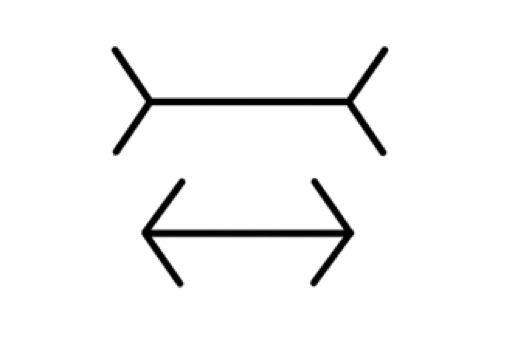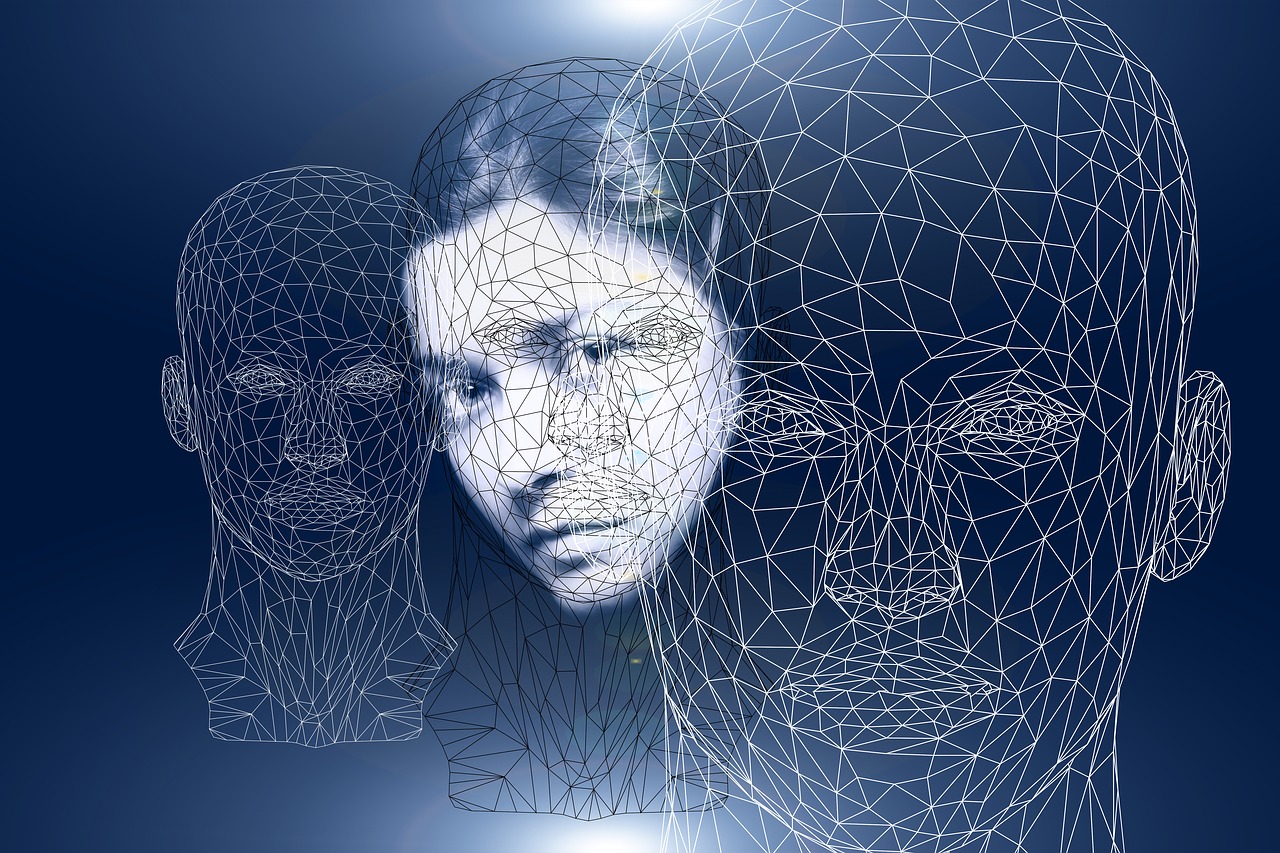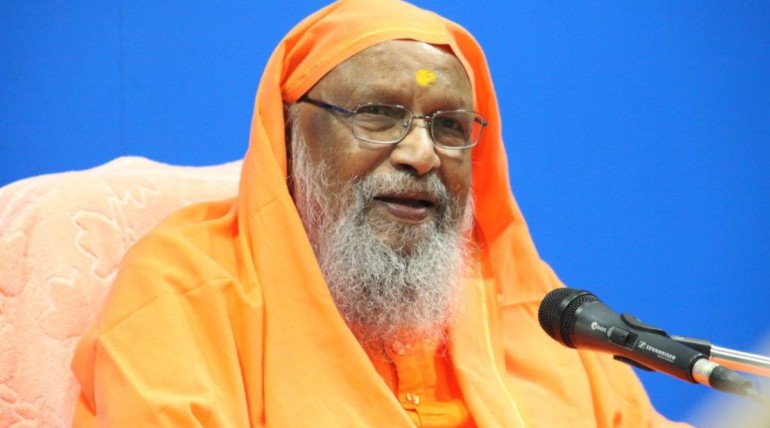Experience and Knowledge
The Subtle and Causal Bodies: David and Goliath

This picture is unremarkable: two horizontal lines of different lengths, with fins appended, pointing in different directions. The bottom line is obviously shorter than the other one above it. That is what we all see, and we naturally believe what we see. If you have already encountered this image, however, you recognize it as the famous Muller-Lyer illusion. As you can easily confirm by measuring them with a ruler, the horizontal lines are in fact identical in length.
Now that you have measured the lines, you – your System 2 (Subtle Body, or apparent person), the conscious being you call “I” – have a new belief: you know that the lines are equally long. If asked about the length, you will say what you know. But you will see the top line as longer. You have chosen to believe the measurement, but you cannot prevent System 1 (Causal Body) doing its thing. You cannot decide to see the lines as equal, although you know they are. To resist the illusion, there is only one thing you can do: you can learn to mistrust your impressions of the length of lines when fins are attached to them.
To implement that rule, you must be able to recognize the illusory pattern and recall what you know about it. If you can do this, you will never again be fooled by the Muller-Lyer illusion.
But you will still see one line as longer than the other!
What is System 1 and System 2?
The terms “System 1” and “System 2” have evolved in modern psychology as documented by the experimental psychologist and Nobel Prize winner, Daniel Kahneman. He describes these systems and many other fascinating insights very beautifully in his book, “Thinking, Fast and Slow.” His book is well worth reading because of its relevance to self-inquiry; both James and I thoroughly enjoyed it. The explanation above is a quote from Kahneman’s book, although I have added the Vedantic terms in parenthesis. From a Vedanta perspective, System 1 is a code term to describe the macrocosmic Causal Body or the Unconscious, meaning Isvara. The Causal Body contains the ‘personal’ or microcosmic Causal Body (often referred to as the subconscious mind). System 2 describes the Subtle Body, or the conscious mind.
The value of Daniel Kahneman’s research is that it provides us with a language which is current, accurate….and more in tune with Western thinking. Unbeknown to him, this language is true to Vedanta and as such, offers an additional and very useful tool in our self-inquiry “tool-kit”. This further enables us to apply the understanding of the environment: the individual (jiva/System 2) its relationship to the macrocosmic mind (Isvara) and pure awareness.
The real meaning of the exercise above, either for the seeker of liberation (moksha) or the average person (samsari) is that reality is not perceived the way it really is, because Isvara wielding maya (System 1) operates the dharmafield (Systems 1 and 2) in such a way that the conscious mind (System 2) is deluded. The conscious mind cannot be blamed for this because it is programmed by maya to perceive reality the way it does: as a duality. As is illustrated in the image above, even though knowledge has forever removed the belief that one line is shorter than the other, the perception still exists. Not all illusions are visual, but all illusions are cognitive illusions because all objects are experienced in consciousness through the filter of our conditioning, System 2.
The experiment above is a simple way to demonstrate how perception functions, and a very good analogy that demonstrates the difference between experience and knowledge. The knowledge that experience is meant to deliver is interpreted by the conscious mind, System 2, according to its conditioning, the Causal Body, System 1.
For the average person who does not question the unexamined logic of his or her experience, duality is taken as a given. Even in the case of the seeker of liberation, when knowledge has removed ignorance of the true non-dual nature of reality, duality still apparently exists; just as a mirage on the desert floor still exists even when one knows it is simply a mirage. This is why you still perceive one line in the illustration above as shorter than the other even though knowledge has removed your ignorance about this and you know that both lines are identical.
The problem inherent in the way reality is perceived by most people is that we do not know what we do not know. Worse, we take ignorance to be knowledge. As long as we are blind but believe that we can see, we continue to suffer at the hands of samsara: the belief that reality is a duality rather than a non-duality, as it actually is.
So what does this mean, and how does it impact on self-inquiry?
Our little experiment with the Muller-Lyer illusion (and there are others of the same kind that illustrate this point) is beneficial for those who inquire into the true nature of reality because it highlights perfectly how the Causal and Subtle bodies function and their relationship to each other. System 1 is ‘our’ conditioning or programming, in other words how Isvara functions and plays out in our human drama as an individual or jiva. It is not personal, although it is personalized by the jiva and creates “our story.” System 1 can also be called maya, ignorance or the cause of duality, the apparent reality.
System 1 can be likened to an information processor, like a computer. It not only provides the raw material for experience, it is responsible for it by setting it in motion and recording it. System 1 is astonishingly powerful and ‘thinks’ so fast that we are almost never aware of the information until after the fact, if at all. According to cognitive neuroscientists, if we had to apportion actual brain function to the two Systems, System 1 has 40 million nerve impulses per second whereas System 2 has 40 nerve impulses per second. This means that System 1 is four million times more powerful … and faster … than System 2!
In contrast to System 1’s computational brilliance, System 2 has only marginal aptitude for creativity. It is a stimulus-response system, with pre-recorded responses totally predicated by System 1. This clearly demonstrates that System 1 controls all behaviour not attended to by System 2, which turns out to be just about everything that is apparently ‘happening’ in present time!
For most of us, System 2 or the conscious mind is so preoccupied with predictable thoughts about the past, present and future, or whatever imaginary problem absorbs it, that it is unaware of the function of System 1. Again according to cognitive neuroscientists, System 2 contributes about 5 percent of our cognitive activity. This means that 95 percent of our decisions, actions, emotions and behaviour are derived from the unobserved processing of System 1, the Causal Body. This process is automatic.
It is believed that of the 4 billion stimuli that are available to the conscious mind at any given moment, only around 2,000 of these stimuli are recorded. And which would these be? Only those stimuli that conform to the individual’s frame of reference: their conditioning. For all intents and purposes, the remaining stimuli do not exist for System 2, although they impact it in unseen ways too numerous to mention. As long as ignorance of our true nature as awareness, and therefore of Isvara, remains, our ‘fate’ is actually under the control of our conditioning or vasana load. This is called bondage and there is no escape from the relentless pressure of the apparent reality, the endless pursuit for completion…..the wheel of samsara, as it is called in Sanskrit. Hence the saying: “Life is something that happens to you while you are busy doing other things.” Or: “Man proposes and God disposes.” System 1 is running in the background at all times and is the real lead in the movie of our lives, although most of us are unconscious of this fact. We think that System 2, the conscious mind, is actually making decisions and running our lives.
The research presented by Kahneman is not postulation or speculation; it is hard science. Corroborated by Vedanta, this should make us re-consider our ideas about free will and doer-ship. It is true that relative free will is available for System 2 in that one can choose an apple over an orange, where one lives or one’s occupation. If this were not true no success would be possible for System 2 and there would be no escape from it. Knowledge of how the two Systems operate is a great help in making more intelligent choices for the apparent person. It will go a long way to ameliorate the effect of the extroverted mind that is beset by the tyranny of its conditioning (its likes and dislikes), driven by desire and buffeted by the uncertainty of life. It is quite clear that there is some other force operating that is the real doer in our lives. However, unless this relative knowledge is seen in the light of self knowledge, there is no real liberation for System 2. Life for the average person or System 2 remains like a computer game: he or she is making the moves to win the game, but actually all possible moves are already programmed by System 1 into the game. It is a set-up, a zero sum game.
In order to effect a change in System 2, whether to gain peace of mind or freedom from the bondage of ignorance, a permanent cognitive shift first needs to take place in System 1. The only way for the conscious mind, ego or System 2 (jiva) to effect a change in System 1 (Isvara) is by introducing a change in the intellect which brings about a change in the thoughts, feelings and the execution of actions in System 2. This is no easy task because System 1 or ignorance is hard wired and very powerful. Think of David and Goliath …. System 2, David, has to aim that blow to System 1, Goliath, very precisely….but it is possible.
This is because there is a two way connection between Isvara and the jiva; even though from a psychological perspective, on the relative level or apparent reality, System 1 and 2 are so unevenly matched. The conditioning that runs System 2 can be changed in System 1 where it originates from, through repeated, appropriate action based on knowledge. When it comes to deeply entrenched conditioning or vasanas, it is extremely difficult and requires constant vigilance. What this entails is every day, moment to moment asserting and re-asserting your nature as awareness with every thought word and deed.
Knowledge of how both Systems function will definitely help manage System 2 and diminish agitation psychologically, but is not enough to set one free. To gain liberation, one has to directly understand the true nature of both Systems; how they come into existence and what the common denominator between them is. This is called self-inquiry.
Ted Schmidt says:
“The jiva (System 2) is able to effect change in Isvara (System 1) through its apparent actions….. due to the fact that the jiva and Isvara share the same essential identity as pure awareness. Fundamentally, ‘enlightenment’ is a matter of awareness recognizing itself as awareness, through the lens of the jiva. Equipped as it is with the functions of mind, intellect, ego, and memory, the Subtle Body (System 2) is the mechanism through which pure awareness can, ironically, neutralize the effects of its self-imposed apparent ignorance and recognize its true identity.
The Subtle Body (System 2) is a mechanism designed and activated by the light of pure awareness, through which pure awareness, while apparently under the influence of its own self-imposed power of ignorance, can apparently experience the apparent reality by means of its extroverted perceptive organs. Even though technically awareness is not an experiencer, it can recognize its true nature when, with the aid of self-knowledge, it turns its focus “within” and consciously neutralizes the tendencies stored in its unconscious mind (System 1 or Causal Body).
The Subtle Body (System 2) is a mechanism designed to function at the behest of the Causal Body (System 1) until such time as it ‘realizes’ the futility of its attempt to find any lasting peace and happiness by following its own lead. At this point, through the application of knowledge, the Subtle Body is able to resist the influence of the Causal Body and realize the limitless bliss that is its true identity.
The functions of the Subtle Body (System 2) — i.e. mind, intellect, ego, and memory — can either be tools utilized by ignorance (the binding vasanas in the Causal Body, System 1) to extrovert the mind and thereby maintain its tyrannical control over the deluded David (the jiva), or they can be weapons wielded by knowledge used to redirect one’s attention ‘inward’ and through inquiry, slay the Goliath of ignorance.” End quote.
If no change of thought takes place in System 2, System 1 will continue running unchanged, by default. Making these changes in one’s thinking in the light of self knowledge is what renders binding vasanas non-binding. It bears repeating here that the application of self knowledge is hard work which requires the constant repetition of thoughts of the limitlessness of one’s true nature, which is beyond both Systems. Only self knowledge is capable of permanently removing ignorance of our true nature. What is clearly not known to Daniel Kahneman and not addressed in his brilliant research is: Who is the knower of System 1 and System 2?
Kahneman is unaware how much more powerful his research would be if he knew the answer to this question is awareness, what James calls System 3.
To make the changes in System 1 stick, dedicated self-discipline, constant vigilance, appropriate lifestyle choices and a devotional attitude are required. With the understanding of how the apparent individual psychology functions, it is easy to see why ignorance is so powerful and so few minds are qualified for Vedanta. It is also clear why without the qualifications required for self-inquiry it is an impossible task to free the mind from its identification with objects and the hypnosis of duality. Freedom is a gargantuan task that can only be undertaken by the purified and highly motivated mind.
What is intuition?
In the words of the famous psychologist Herbert Simon, who had great impatience for the mythologizing of intuition: “The psychology of intuition involves no magic!” The fact is our everyday intuitive abilities are no less marvelous than striking insights or “out of this world” epiphanies……only more common.
When ‘intuition’ is supposedly operating, Simon says: “The situation has provided a cue; this cue has given the person access to information stored in memory (Insert: Causal Body/System 1) and this information provides the answer. Intuition is nothing more and nothing less than recognition.”
This is why intuition is not a valid means of knowledge; it is memory and experience based and therefore based on ignorance. Only knowledge can reliably provide the information we need to free the mind from its programmed ways of perceiving reality.
Sundari



